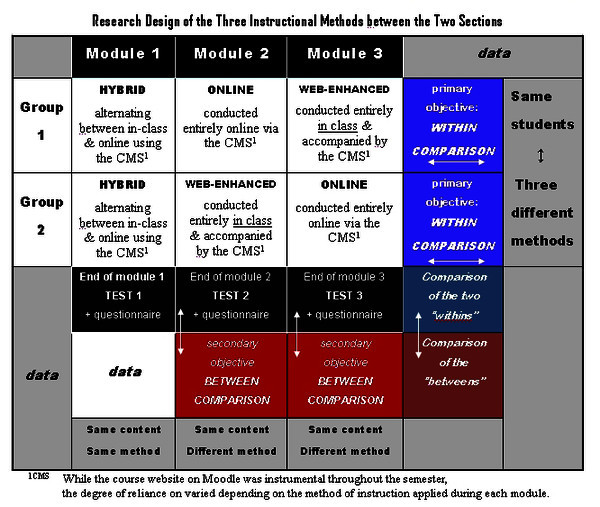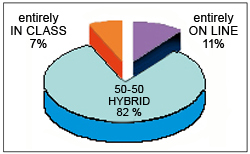Investigating the Effects of Technology-Assisted Instruction on Cégep Students
The virtual learning environment may be a new frontier for many teachers and students alike. Some pedagogues may even question the didactical effectiveness of a platform that relies on electronic means to serve as a vehicle for instruction. Initially, I too was a skeptic, which is why I chose to investigate the effects of varying degrees of technology-assisted instruction for my Master’s research, and then I became an enthusiast.

A General Overview of Kolb’s Learning Styles, a concept discussed in Helen Stavaris’ Master’s Thesis.
Allow me to give you a glimpse of how I teach in the online environment before presenting an overview of my study and its related findings. My personal preference as an instructor is the hybrid method (also known as “the blended approach”), which incorporates both virtual and physical learning environments. I find that this allows students to benefit from “the best of both worlds”, and also responds well to the different individual learning styles. I tend to favour an asynchronous approach (where students manage the online learning activity requirements any time before the specified deadline) particularly when class sizes are large. This allows students to not only have the flexibility of when to do the online learning activity, but also have more time to contemplate their answers before responding.
I feel that I have taken student learning to a higher level as a result of implementing the hybrid approach. The best example is how I have reformatted the course Human Resource Management offered to the third-year students in the Business Administration Program. Every week for their online class, students have to read and analyze an assigned case (typically a landmark case from the headlines) and provide their analysis and references to the course material in an online submission using Moodle. I know everyone has read and considered the material because they get graded on these weekly electronic submissions. When we meet in class, the discussions are more meaningful and more productive. As the instructor/facilitator, I have greater certainty that students develop competence and an appreciation towards higher levels of learning.
If you are wondering whether it is easier for the teacher, the quick answer is no. There is a significant time investment required by the instructor (especially for first-time implementation) to design, maintain and monitor virtual aspects of the course. For the one or two hours removed from the classroom, I must spend at least two to three times as much more time reading and guiding discussion boards and commenting on electronic submissions. It is different from the traditional classroom setting, and therefore requires a different approach. Success in such a setting hinges on designing instructional strategies that revolve around, among other things, developing a coherent structure and maintaining guidance and support through a strong virtual presence. Since it offers several new avenues that enrich learning opportunities; this makes the time investment all worthwhile.
My Research Study in a Nutshell
For the purposes of research towards my Master’s degree in Education, I investigated how variations of technology used in instructional delivery affected first-year Cégep students. Essentially, the study contrasted three methodologies that relied on technology differently: 1) online method – an entirely electronically-based approach, 2) in-class method – a fully in-class setting that was accompanied (enhanced) by a course website, and 3) hybrid method – comprising of a combination of both online and in-class methodologies. After having researched several studies in education literature, a pivotal aspect of my study was that the same students be involved in making the comparison between the different instructional methods. The table below explains how I achieved this goal.

Research Design of the Three Instructional Methods between the Two Sections
Overview of the Results of My Study
My study focused on three research questions which related to preference, performance and learning styles. In terms of student preference, students were asked to indicate which of the three methods of instructional delivery they would prefer to follow if they had to take the course again. A sizeable 82% of the participants selected the hybrid method attributing such factors as flexibility and convenience as the primary reasons for their preference. Aspects of self-paced learning were also found to be the most appealing pedagogically-related features of the online environment. Nevertheless, face-to-face interaction with the teacher was also significantly important to students, also evident by the selected preferred method.
A closer investigation in relation to individual leaning styles was made with those who had selected either the entirely in-class method (7%) or the fully online approach (11%). Using Kolb’s framework as the diagnostic assessment tool, those who had selected the in-class approach were associated to a learning style characterized by the need for detailed explanations and theories, while students who selected the purely online method were found to have learning preferences that involve learning by doing.
Of course, the big question always relates to how instructional methodology affects student performance. Similar to other such comparative studies, there was no evidence found in my study to indicate that test performance was affected by the absence of face-to-face interaction with the instructor. My study also investigated the influence of the learning environment on formative assessments, but for more information on this, you are able to refer to my complete study which explains these as well as all the research findings in detail.

Students’ Preferred Method of Instruction from Helen’s Stavaris’ research study (2010)
Some Words of Advice
The best advice I can give to anyone considering applying online pedagogy is that it requires a shift in thinking from traditional practices in terms of content delivery and teacher presence. Instructional strategies have to be modified in order to be made suitable for the online platform. Essentially, teaching in the virtual environment relies on the individual instructor’s teaching philosophy just as in the traditional classroom setting. The goal is always to formulate the optimal instructional strategy that achieves learning objectives within a stimulating and active learner-centered environment.
With so many possibilities and benefits available, the virtual learning environment is certainly worthwhile exploring, especially because when done well, students love it!

